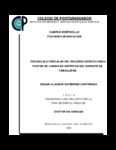Estudio multiescalar del recurso hídrico como factor de cambio en distritos del noreste de Tamaulipas
Abstract
A partir de 1994, la Tercera Unidad de Asistencia Técnica del Distrito de Riego No. 026,
región noreste del estado de Tamaulipas, fue modificado por un déficit de humedad colocando a
la región en una situación de alta vulnerabilidad social, económica, política, cultural y
agroecológica. Debido a la complejidad del problema se llevó a cabo una investigación
multiescalar desde, el nivel mega-macro hasta el microscópico empleando diferentes
metodologías: interpretación de imágenes de satélite, uso de sistemas de información geográfica,
creación de bases de datos (90,500 piezas), encuestas directas con productores, análisis físicos,
químicos, mineralógicos y micromorfológicos de suelos. Los objetivos que se plantearon fueron:
1) Evaluar el uso de la percepción remota con la elaboración de la cartografía temática
proveniente de imágenes de satélite de baja y alta resolución, obteniéndose estadísticas agrícolas
de los cultivos de sorgo y maíz; 2) Estudiar las acciones llevadas a cabo por los agricultores para
mitigar el impacto de déficit de agua; y 3) Determinar los cambios en las propiedades edáficas y
establecer la clasificación taxonómica de suelos con y sin alteración del régimen de humedad. Se
encontró que la estimación de la superficie agrícola por muestreo en campo fue más precisa y
consistente (90%) que la calculada por percepción remota (entre 20 y 80%). La gran
comunicación entre productores evitó la disminución de la superficie agrícola al cambiar el
patrón de cultivo y distribuir homogéneamente el recurso hídrico. Las propiedades edáficas en
las áreas de temporal y de riego, no se alteraron pero si en los suelos cercanos a los canales de
riego. La clasificación taxonómica de los suelos se modificó de Aridisoles a Inceptisoles por el
cambio del régimen de humedad._________Since 1994, the agricultural scenario in the Third Unit of Technical Assistance, belonging
to the 26th Rural District, northeast of Tamaulipas, was modified by a moisture deficit, which
situated the region in a state of high vulnerability in terms of economic, politics, cultural, social,
and agro-ecological point of view. Because of the complexity of the problem, a multi-scalar
research was carried out, including from “mega-macro” scales to microscopic scales. Different
procedures were applied using satellite images, geographic information systems, multiple
databases, direct interviews to farmers, and soil laboratory analysis, including physical,
chemical, mineralogical, and micro-morphological tests. The objectives of this research were to
1) evaluate the application of remote sensing to mapping corn and sorghum crops and estimating
crop yields of these two species using low and high resolution images; 2) study the actions
performed by farmers in order to mitigate the impact of water deficit; and 3) determine the
changes in soil properties to establish the taxonomical classifications of irrigated and non-
irrigated soils. It was found that sampling the data was more precise (90%) than remote sensing
(20 – 80 %), to estimate crop cover and yield. Additionally, the efficient communication between
farmers avoided the reduction of agricultural surface, by shifting crops and distributing equally
water resources. Soil properties were not significantly different among irrigated and non irrigated
areas; however, there were changes in soil properties between soils near to the channel mean
from those far to the channel. Therefore, the taxonomic classification of soils near the channel
changed from aridisols to inceptisols, because of the change in moisture regime.
Collections
- Tesis MC, MT, MP y DC [349]


